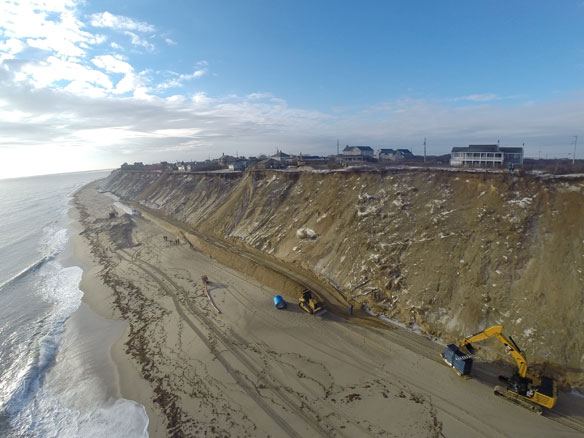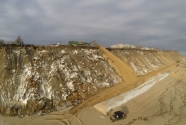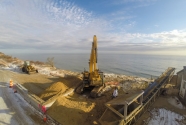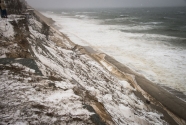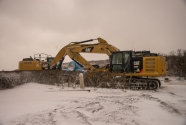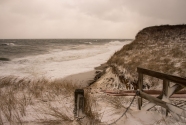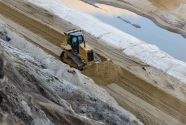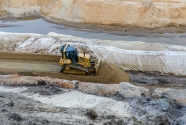By © Nantucket Coastal Conservancy;
A NEW YEAR FILLED WITH RESOLVE AND PROMISE
“We are lifted up by the outpouring of concern voiced by citizens far and wide for Nantucket’s beaches. The destruction of our pristine beach below the bluff in Sconset, a legacy from the Proprietors to future generations of islanders and visitors, is simply unacceptable.
As 2014 begins, we resolve to re-double our efforts to come together to preserve and protect one of Nantucket’s most precious, and threatened, resources, as evidenced by what has been happening in the past days. The photos speak for themselves.
Coastal communities in the Commonwealth, as well as up and down the seaboard, are dealing with the issue of erosion and erosion control. The situation Nantucket finds itself in — wealthy property owners who want to protect their investments at any cost, adjacent property owners who may be harmed by the adverse impacts of various proposals, citizens concerned with the environmental impacts of what is being proposed, local government officials caught between constituencies, contractors who stand to benefit from the money to be spent, the difficulty and reluctance, especially in a small island community, of speaking out against neighbors — is not unique.
However, Nantucket is Nantucket. We treasure our natural coastline. Our beaches make us who we are. They are a key driver of our economy. Going forward, we commit to working even harder to bring our community together to ensure that this knowing destruction of our environment never happens again. Please join us. Wishing all a New Year filled with resolve and promise.”—Nantucket Coastal Conservancy.
NANTUCKET’S BIG DIG: How could it happen?
The Siasconset Beach Preservation Fund (SBPF), a private, not-for-profit organization formed by property owners in the early 90s, has been trying unsuccessfully to hard-armor Sconset Bluff. They are attempting to stop, or at best delay, the forces of nature to protect their houses that are perched on the edge of this iconic eroding headland.
Erosion has been an issue in the eastern area of Nantucket for millennia: when the original lots were laid out on Baxter Road in the late 19th century, the developer purposely included land on the western side of the street, so that there would be room to relocate structures threatened by erosion. Unfortunately, much of that property has been sold over the decades, so is no longer available.
The beach below the bluff is a public one, owned by the citizens of Nantucket, a legacy from the Proprietors who took positive action in the 1880s to ensure that this stretch of coast would be in the public domain in perpetuity.
The Nantucket Conservation Commission (ConCom), comprised of seven members appointed by the Board of Selectmen, is responsible for implementing and enforcing the Nantucket Wetland Bylaw, as well as the State Wetlands Protection Act, both of which safe guard wetland resources such as coastal banks, dunes and beaches. The local bylaw is more restrictive than the State statute.
SBPF has received numerous permits from the ConCom during the past twenty-or-so years to install several different forms of soft erosion-protection alternatives that have had varying results.
However, within the past few years, SBPF has been attempting to get approval from the ConCom to install hard-armoring structures without success. ConCom has denied a number of hard-armoring proposals put forth by SBPF, including two variations of rocks in metal baskets (gabions), as well as a four-layer geotextile sea wall. A proposal for a 4,000-foot rock revetment is currently on hold.
What are the differences between soft and hard coastal-erosion alternatives? Soft options are designed to work with Mother Nature, to mimic the natural coastal processes and minimize adverse impacts. Soft alternatives are consistent with both local and State law, as well as the best practices for coastal management, as contained in the Storm Smart Program developed by the Office of Coastal Zone Management, a part of the Executive Office of Energy and Environmental Affairs of the Commonwealth of Massachusetts.
“We treasure our natural coastline. Our beaches make us who we are…”
— Nantucket Coastal Conservancy
Hard erosion-protection alternatives, on the other hand, are attempts to draw lines in the sand, to work against Mother Nature and to wall off the sea. Hard coastal engineering structures are inconsistent with local and State law, except under certain circumstances, and have been prohibited, not only in Massachusetts, but also in other states as well.
According to Mr. Joseph Vietri, Director of the National Planning Center for Coastal and Storm Damage for the U.S. Army Corps of Engineers in New York, even the Army Corps does not recommend sea walls facing open ocean, as in Sconset: “And I would agree 100 percent—I am very much and we very much do not recommend walls or any kind of vertically aligned structures along an open ocean coastline.”
After the storms of last winter and spring, erosion in a northern section of Baxter Road, the public way that runs along the crest of the bluff with houses on both the east and west of it, accelerated. The Town of Nantucket, which has an obligation to provide access and utilities to structures located on Town-owned roads, acted to provide such services by securing alternate access to the properties from the west, or landward side of Baxter Road.
At this point, SBPF, citing an emergency, entered into a Memorandum of Understanding with the Town to attempt to abate the emergency by providing “temporary” protection to the toe of the bluff and keep Baxter Road from breaching while alternate plans were put in place. In return, SBPF agreed to fund this phase of the agreement.
However, if the Town declined to “cooperate” with SBPF in attempting to stabilize the toe of the bluff, residents in the area made it clear that they would, in turn, refuse to cooperate with the Town in securing alternate access and would “exercise their legal rights” to thwart the Town’s acting on its own.
A proposal to install a 4,000-foot rock revetment was filed with the ConCom by SBPF and supported by the Town. After a less-than-promising series of hearings held this summer, the project has been put on hold by the applicant, who filed a second hard-armoring proposal, this time with the Town as co-applicant, for a four-layered geotextile sea wall.
After due deliberation, the ConCom indicated that there were “reasonable alternatives” to the geotextile wall, citing a preferred soft solution, sand-filled jute bags. Following this vote, the proposal was modified, as requested by the Commission, to a hybrid structure, part geotextile tube and part jute bags.
However, SBPF wanted what they wanted: a hard-armoring solution. They persisted and, as a single applicant without the Town, filed an Emergency Request for a four-layered geotextile sea wall, the same project that the Commission had previously indicated they would not permit. The Emergency Request was denied by a vote of 5-to-1. (Almost simultaneously, the Town filed for an Emergency Permit, as sole applicant, for the hybrid structure which was approved by the ConCom, on a vote of 5-to-1.)
SBPF immediately appealed the decision to the State DEP under the State Wetlands Protection Act. A hearing was held on site by the DEP. The Regional Director issued an order shortly thereafter approving an emergency, 30-day permit to construct the four-layered, hard-armoring project, although local approval had not yet been secured.
Subsequently the Town joined SBPF in applying for a new, joint Emergency Permit, again seeking approval to install a four-layer geotextile wall. SBPF, as well as the Town, cited the DEP approval of such a structure on appeal as evidence of its appropriateness to the situation and its compliance with environmental standards, at least on an emergency basis.
The Nantucket Conservation Commission, which has been hearing the various joint SBPF-Town proposals for erosion control projects in the area since July, approved a 30-day Emergency Permit for a three-layered project, not a four-layered one as proposed. A number of Commissioners expressing misgivings, preferring the hybrid option, but obviously were influenced by the DEP ruling.
Construction work began immediately.
Sharon and Dirck Van Lieu, principals of Van Lieu Photography, have been blogging and documenting the installation of the project, now in progress. This “temporary” installation, as evidenced by the photos, has been repeatedly referred to as “Nantucket’s Big Dig.”
And it is.
The project is estimated to cost in the vicinity of $2.9 million, to be paid by SBPF. It will require monitoring, maintenance and mitigation for as long as it is in place. According to testimony before the ConCom, it will result in the narrowing of the public beach and its eventual destruction.
Under the rules of an emergency permit, the applicants must file a standard Notice of Intent within 30 days to seek a regular permit for the project. The Commission could conceivable deny the application, and, if it does, could order the $2.9 million sea wall to be removed.
According to the provisions of the Memorandum of Understanding (MOU) entered into by SBPF and the Town (by a split Board of Selectmen vote of 3-to-2), this project is only phase one of a multi-phase effort. As stated in the MOU, the BOS has agreed that when the time comes they will seek taxpayer funding for extension of the installation.
A prominent local scientist has referred to these types of projects — revetments of rocks or geotextile tubes — as the “most environmentally damaging” ever to happen to Nantucket, if permitted and installed. A former ConCom Chair has publicly called hard-armoring as “antiquated as jousting and probably not as effective.”
Clearly, the State approval has had an impact.
How could the State Department of Environmental Protection (DEP) have approved an Emergency Order for a geotextile sea wall that had been denied by the Nantucket Conservation Commission, not once but twice, and is antithetical to all of the best practices of erosion-control recommended by the Commonwealth of Massachusetts through its Office of Coastal Zone Management (CZM)?
Are people with money and influence and enough persistence able to get what they want at the State level, despite repeated denials by the local permitting body? Could this action by the DEP have been a political one, not an environmental one?
Concerned citizens believe that this matter is worthy of full inquiry, as the harm to Nantucket and its environmental resources as well as its regulatory processes are without precedent. Islanders have been careful and attentive stewards of the Nantucket environment. They have been cited for their efforts in this regard over the years, notably with the establishment of the Land Bank in the 70s, the first of its kind in the country.
How could Nantucket’s Big Dig happen?
The community needs an answer.
A FIRST STEP
A first step is to hold our local elected officials accountable for their decisions. None of this would have been possible without a majority of the Board of Selectmen, three of whom have voted consistently to support the endeavor underway in Sconset.
“Sand, the new gold on Nantucket?.”
— Nantucket Coastal Conservancy
The decision to license the public beach below the bluff was made at a 4:00 meeting on a Friday afternoon just before the holidays — this, despite the fact that the citizens of Nantucket have indicated time and time again that we want to have a say in how our land will be used.
Not only did we not have a say, the reality is that the decision made by three of our highest elected representatives will result in the loss of our beach, a legacy to the people of Nantucket from the Proprietors.
There is time for the Board to reconsider. There are less harmful alternatives that will still enable the Town to meet its obligations.
These three members need to hear from concerned citizens, just as they have been hearing from SBPF and Baxter Road residents. Here is their email contact information. Communications to the entire Board of Selectmen can be sent to Erika Mooney, Executive Assistant to the Town Manager, with the request that the information be shared with the BOS members. However, one-to-one, personal contact is the most effective, as we know.
LOOKING FORWARD
Heading into the New Year, our resolve remains steadfast. We commit to re-doubling our efforts to preserve and protect Nantucket’s natural beaches.
First and foremost, we will organize ourselves in a more formal way, providing non-profit structure and governance for our grass-roots group that has grown strong and broad from our original advocacy beginnings.
It is clear that this issue is going to be the seminal one for Nantucket for the immediate and foreseeable future, and, with your support, we intend to marshal the resources necessary to address it in an effective way. Quite frankly, we have been hesitant to form one more non-profit organization, but given the events of the past few months, our mission is more urgent and longer-term than we had originally envisioned.
More specifically, we will continue to monitor upcoming hearings and provide timely and fulsome reports. We will continue to compile photographic documentation of the installation currently under construction in Sconset, as well as other projects around the island. We intend to upgrade our website and make it the go-to place for current and accurate information about this important issue, once we have the financial resources to do so. We will continue our almost daily postings on Facebook and invite you to join the hundreds, now thousands, of people who read them on a regular basis.
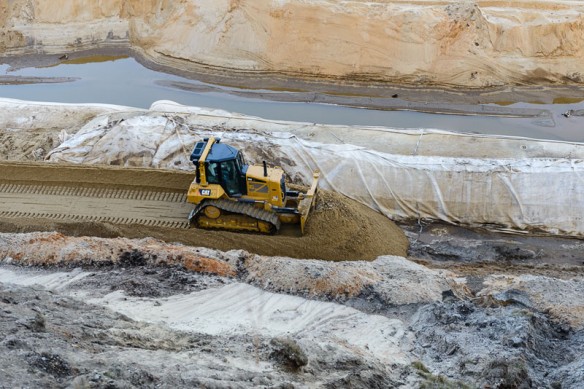
Sand, the new gold on Nantucket?
Martin McKerrow provides excellent photographs illustrating the use of sand excavated from mid-island for this project. The mitigation alone will require 22 cubic yards of sand per linear foot of the project, 900 feet, on an annual basis, more if needed, to offset adverse impacts to adjacent coastal areas. At this point in the installation process, it appears that the excavated sand, transported by dump truck through Sconset to northern Baxter Road, is being used to provide fill for the geotubes, as well as back-fill, as the three-layered structure is put in place. Captions and Photo, courtesy of: © Nantucket Coastal Conservancy.
ABOUT THE AUTHORS: Nantucket Coastal Conservancy
“As you may know, the Nantucket Coastal Conservancy is a grass-roots coming together of concerned citizens, a diverse group of fishermen, environmentalists, naturalists, seasonal and year-round residents, who originally advocated against the SBPF beach-dredging proposal in 2009. Since that time, we have re-grouped with a broader mission: To preserve and protect Nantucket’s coastal resources, especially our natural beaches. We are especially concerned about the hard-armoring of the iconic ’Sconset Bluff and the adverse consequences that such a huge, engineered wall of rocks or geotextile tubes will have on our environment, and our beaches.”

